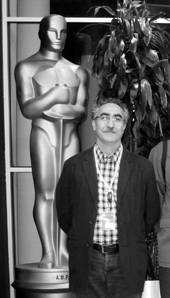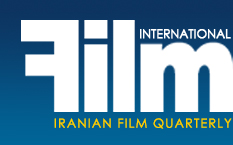|
I am sure that ...
Through Eastern Eyes
by Farhad Tohidi
|
 I was 24 when diplomatic ties between Iran and United States were severed. It was one of my last days as a student of dramatic literature at Dramatic Arts Faculty. It was a short distance from our faculty to the American embassy. I used to pass by the embassy twice everyday when going to the faculty and coming back. The embassy was now occupied by students. I do not remember what precisely I used to think while passing by the embassy. The area around the embassy looked like a fairground. People were there day and night to demonstrate. Some were there just out of curiosity. They were hanging around as if they wanted to discover the secrets of the red bricks and the picture of an eagle just in front of the building. If one was patient enough to stay around, one would have heard different viewpoints as well as facts and fallacies about what was going on the other side of the wall. I was 24 when diplomatic ties between Iran and United States were severed. It was one of my last days as a student of dramatic literature at Dramatic Arts Faculty. It was a short distance from our faculty to the American embassy. I used to pass by the embassy twice everyday when going to the faculty and coming back. The embassy was now occupied by students. I do not remember what precisely I used to think while passing by the embassy. The area around the embassy looked like a fairground. People were there day and night to demonstrate. Some were there just out of curiosity. They were hanging around as if they wanted to discover the secrets of the red bricks and the picture of an eagle just in front of the building. If one was patient enough to stay around, one would have heard different viewpoints as well as facts and fallacies about what was going on the other side of the wall.
I was a film and literature fan and knew the United States, like many other places, in the same way as it was presented in books and films. The fragmented pictures I had in mind of the United States came from the novels of Mark Twain, Ernest Hemingway, William Faulkner, William Saroyan, Saul Bellow, Salinger's Catcher in the Rye, which I loved, as well as the stories of Carver and the plays of Eugene O'Neal, Tennessee Williams and Arthur Miller. I had still not discovered E. L. Doctorow and Paul Auster had still not started to write. Cinema stitched these images together. Those days, I watched American classics at film centers and student associations and enjoyed the works of Scorsese, Coppola, Milos Forman and Sidney Lumet. It was a short while after I had watched Martin Ritt's The Front featuring Woody Allen. These images of the United States were completed with the letters of the girl I loved and later I married. At that time my wife lived and studied at Seattle and I tried through my letter to let her know how much I loved her. Homa's letters did not only describe natural beauties of the United States. She also presented a lively and true picture of the American people in her letters. The people she knew were kind and cultured and helped her and her sister in spite of all the cultural differences that separated them.
Thirty years later, just as I turned 54 and while political taboos still weighed down on the two nations’ relations, I was going to visit the United States with a number of my colleagues. Now, there was an opportunity to put together what I had read with what I was going to see. Now, I could compare them.
A year before, Board members of the Academy of Motion Picture Arts and Sciences had visited Iran. It was a bold measure. Unfortunately, the media had built an unfavorable image of Iran over the years which disturbs those who are willing to visit the country. Fortunately, their visit took place in a favorable situation. Apart from the useful negotiations they had, meeting our American colleagues provided opportunities to flourish friendship. Iranians believe there is no capital dearer than a good friend. The main achievement of that visit was to find good friends, who in spite of their international fame were humble, warm and kind: Sidney Ganis, Annette Bening, Alfre Woodard, Frank Pearson, Phil Robinson, William Horberg, Tom Pollack and the very dear Ellen Harrington.
When our aircraft reached Los Angeles at 7 pm on October 8, I was burning with curiosity. The natural settings around Los Angeles were so similar to Tehran. It was as if the aircraft was landing on the tarmac of Mehrabad Airport in Tehran. There were the same mountains, the same deserts and the same dust that hangs over Tehran all the time.
For us, Iranians, Los Angeles has a different meaning. The largest group of Iranian expatriates lives in this city. There is a constant flow of passengers between his city and Tehran. Families go back and forth to visit their loved ones. Satellite TV networks based in this city broadcast programs for viewers in Iran. Many Iranians still like the pop music produced here by old and young Iranian artists. The sum total of these relationships has led the Iranians to call Los Angeles, "Tehrangeles".
SUBSCRIBE
[Page: 32]
|
|
|
|
|
President & Publisher
Massoud Mehrabi
Editors:
Sohrab Soori
Translators:
Sohrab Soori
Behrouz Tourani
Zohreh Khatibi
Saeed Khamoush
Contributors
Saeed Ghotbizadeh
Mehrzad Danesh
Advertisements
Mohammad Mohammadian
Art Director
Babak Kassiri
Ad Designers
Amir Kheirandish
Hossein Kheirandish
Cover Design
Alireza Amakchi
Correspondents
E.Emrani & M. Behraznia (Germany)
Mohammad Haghighat (France)
A. Movahed & M. Amini (Italy)
Robert Richter (Switzerland)
F. Shafaghi (Canada)
B. Pakzad (UAE)
H. Rasti (Japan)
Print Supervisors
Shad-Rang
Noghreh-Abi
Gol-Naghsh
Subscription & Advertising Sales
Address: 10, Sam St., Hafez Ave., TEHRAN, IRAN
Phone: +98 21 66722444
Fax: +98 21 66718871
info@film-magazine.com
Copyright: Film International
© All rights reserved,
2023, Film International
Quarterly Magazine (ISSN 1021-6510)
Editorial Office: 5th Floor, No. 12
Sam St., Hafez Ave., Tehran 11389, Iran
*
All articles represent views of their
authors and not necessarily
those of the editors
|
|
|

